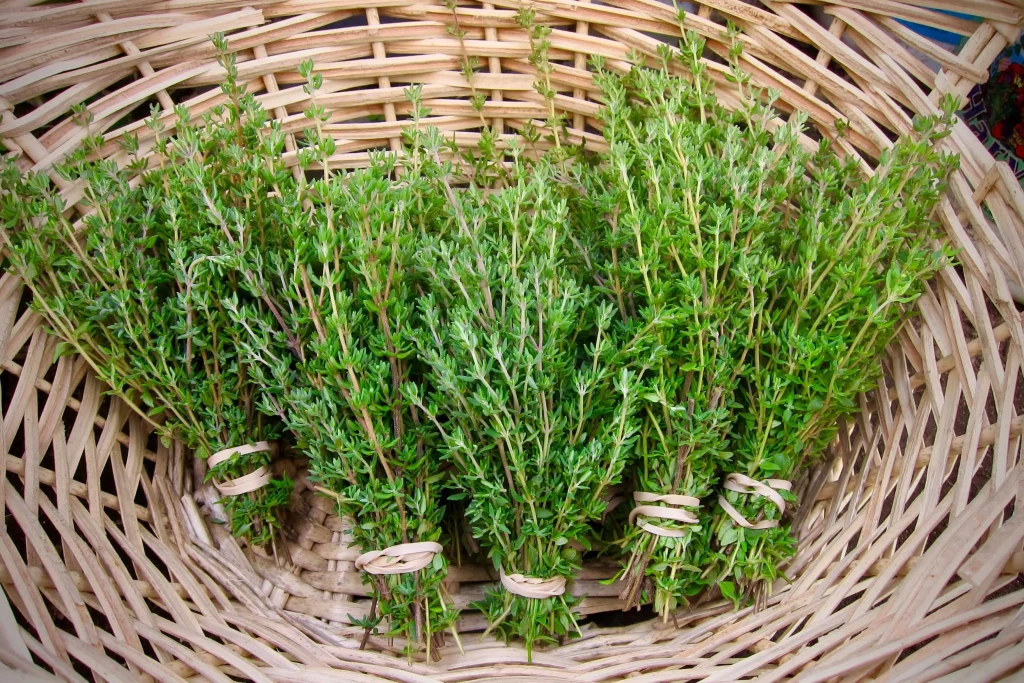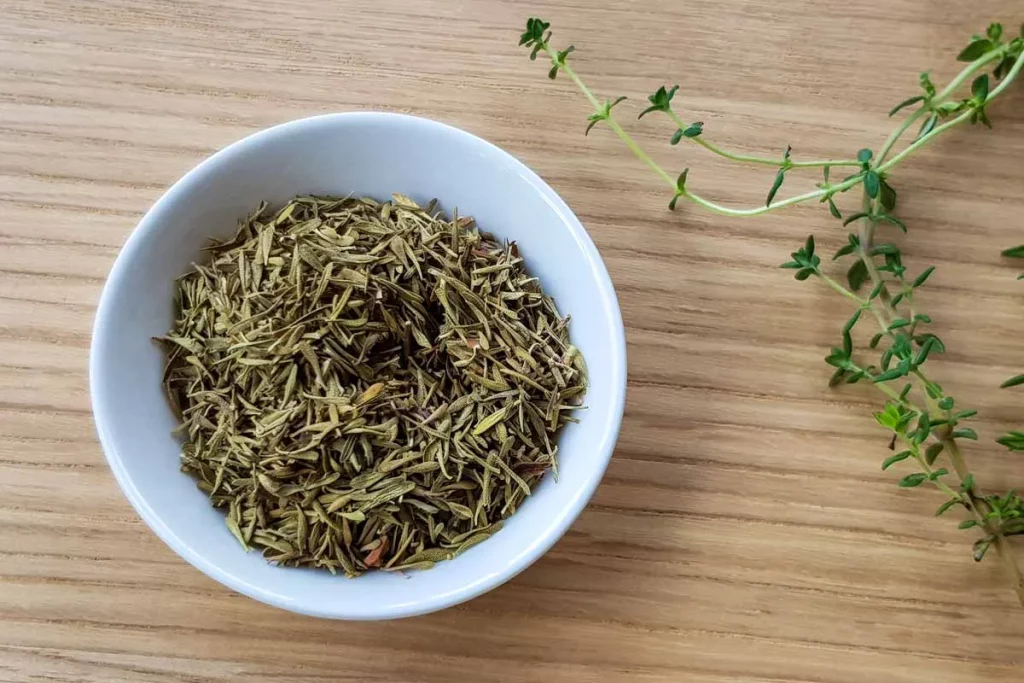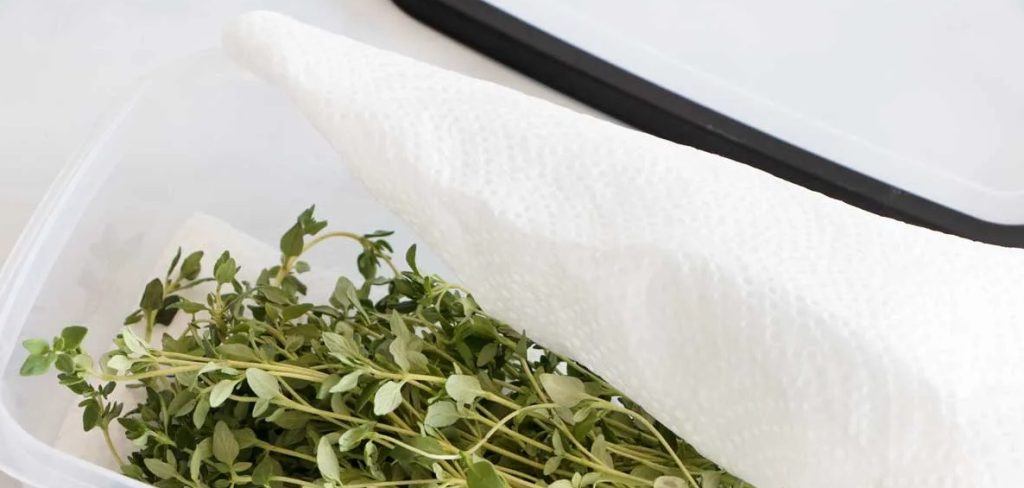Thyme is one of the most famous and popular herbs. It is not surprising that all gardeners try to grow it on the site during the spring and summer. Many are interested in how to harvest thyme in the herb garden.

Contents
Plant features
Before proceeding to the study of the question, of how to harvest thyme in spring and summer, you should familiarize yourself with the characteristics of the plant. Thyme is a plant that originated in Mediterranean countries. It is drought tolerant. The bushes are low, and evergreen and fragrant leaf plates are formed on them.
Prefers to grow in well-drained soils with plenty of sunlight. However, the plant quickly adapts to other conditions. If the climate is humid, it may be difficult to grow thyme.
Almost all types of thyme are considered perennial crops. If you live in a cold region, then you should bring them indoors for the winter.
Thyme is often used in cooking. However, no one bothers you to grow it as an ornamental plant in the garden.
The thyme thrives with beautiful flowers. The thyme plants flower attract bees and butterflies. If conditions for growth are acceptable, the bushes will quickly grow on their own. Therefore, there is the possibility of growing thyme as a plant that covers the soil.

Thyme varieties
There are many different types of thyme in nature. They can be both culinary and decorative. You can eat decorative species; however, they do not have a rich taste. Their feature is in appearance.
In total, there are about 300 different varieties, and the category of the most popular includes:
- Ordinary thyme plant. It is in demand in cooking and has a classic taste.
- Lemon thyme. Often used in cooking because it has a lemony taste and aroma. The lemon thyme plant can be grown as an ornamental plant because thyme leaves are variegated and have a golden color.
- Woolly thyme plant. Differs in excellent decorative qualities. The leaves are fluffy and have a gray-silver tint. Suitable for window sills or creating a rock garden.
- Elven thyme plant. The height of this wild variety is only up to 2 inches. At the same time, the leaves have a rich aroma. The thyme plant flowers are pink or purple and are small in size. Ideal for planting between paving stones, stones, or bricks in the yard.

How to harvest thyme?
There is nothing complicated in growing thyme. However, there are a few rules to follow if you are interested in how to harvest thyme.
Cutting or transplanting
If you plan to grow thyme from seeds, you may have some difficulties. Therefore, it is better to immediately buy a finished plant or use cuttings.
If you plan to start from cuttings, it makes sense to immediately take an adult plant of the desired variety.
Use garden shears to cut off some of the thyme stems to make a 3-inch-long cutting. Pour some moist soil into the pots first.
Dip the cutting in the growth stimulator, then stick it into the soil. Place the airtight container in a warm place. For several weeks, you need to constantly moisten the soil.
After 4–6 weeks, the cuttings take root. Transplanting into the open ground is carried out as soon as the plants fill the pots.
Landing features
Landing should be carried out in warm soil. The place should be sunny, with well-drained soil. The optimal distance between the bushes is 12-24 inches.
After, you need to water the plants until they take root.
The main thing is not to water the soil too much. The peculiarity of thyme is that it does not conflict with other plants and herbs in the garden.

How to care for thyme?
As soon as the plants take root, they do not require careful care. It needs watering during dry periods.
With an interval of 3-4 years, the division of the bushes or their replacement is required.
Especially if you plan to use the culinary herb.
As the stems mature, they become covered with bark and the leaves lose their fragrance. Therefore, pruning at intervals of 1-2 years is required. This will encourage the growth of new plants.

When to start harvesting thyme?
Harvesting thyme is allowed at any stage of the growing season once the bushes have grown.
You can safely cut off some stems if you plan to use the plant in cooking. You can even pluck a few leaves if required.
If you plan to dry thyme, you must harvest thyme before flowering begins. Then the grass has the most intense flavor.
Harvesting is carried out in the morning, as soon as the dew dries. At this time, the leaves contain the largest amount of essential oils, which give a rich aroma.

Features of the collection of thyme
As soon as you decide to harvest thyme, you need a sharp tool and a basket for collecting greens.
At each harvest thyme, cuttings of 5 inches should be left so that the bushes can recover. You can harvest a lot or a little, depending on your preferences.
If you’re going to dry thyme, it’s best to cut the stems that are 5 to 6 inches long. Arm yourself with a sharp tool and cut off the top of the stem.
Leave the fate that is covered with bark. After all, they are too hard and have already lost most of the flavor.
It is recommended to cut above the growth node so that the plants can branch better later on. When the stems are cut, the leaves can be removed from them using a special tool. Leaves are much more convenient to add to various recipes.
If you don’t plan to use thyme right away, you can store it in the refrigerator. Shelf life – up to 2 weeks.
To do this, the stems are wrapped in a damp paper towel. Lay the greens after you need to in a resealable plastic bag. If you want to increase the shelf life of thyme, you can dry it.

How to dry thyme?
To keep fresh thyme for longer, you can dry them out and store them in airtight containers.
Herbal preparation
As soon as the freshly harvested thyme is collected, it must be washed under cold water. It can be flowing, or collected in a bowl. It is necessary to remove the maximum amount of pollution. However, be careful not to damage the leaves.
Spread the washed greens on a towel in one row, and blot dry. It can be air-dried until moisture is completely evaporated.
For drying, it is better to choose long stems because they can be hung. This will prevent mold from forming.
Drying grass
Once the moisture has been removed, you can gather the greens into bunches. Each of them should have no more than 6-8 stems.
You need to tie them with twine. If there are paper bags, you can wrap the bundles in them, and make cuts for air to pass through.
Place the bundles in a dry and warm place. Avoid direct sunlight. The better the airflow, the faster the herbs will dry out. Therefore, it is better to place everything in a well-ventilated area.
It takes several weeks for freshly harvested thyme to dry completely. The exact timing depends on the conditions that were created. Herbs are ready for long-term storage as soon as they start to crumble and have a crispy texture.
Application of a dehydrator
You can use a dehydrator for fresh herbs to speed up the drying process. The preparatory steps are the same as in the previous version.
After that, the stems should be laid out in one layer on the trays of the device. Before starting the dehydrator, you should study the instructions for its operation to avoid errors and breakdowns.
This determines the optimal temperature for drying the grass. Often low settings are required.
If you use a dehydrator, you won’t have to keep an eye on your thyme and check it. The main thing is to make sure that the stems do not burn.
Once the thyme has dried, let it cool down. On average, it takes about 1 hour. After that, you can put it away for long-term storage.

How to store dried thyme?
Once the thyme has dried, as mentioned, it needs to be sorted into containers. This extends its shelf life.
Opt for glass containers that have airtight lids. For every day, you can choose a small container that is specially designed for storing herbs.
Herbs that you plan to use in the future should be stored in glass containers. They must first be washed and dried thoroughly. Thyme can be stored as whole stems or as cut leaves. They are much easier and faster to use.
However, be careful not to let the leaves fall apart. If they remain intact, this preserves the maximum amount of taste and aroma for a long time.
Then put the herbs in a container, and place them in a dark and dry place. Keep them away from heat sources.
Dried thyme lasts several months. At the same time, you can add it to various dishes, or make them infused with oils.

Features of storing fresh thyme
Some housewives prefer to use fresh thyme. In this case, you should refuse to wash it. This causes the aromatic oils to wash off. To preserve the taste, greens should be used within 72 hours after you harvest thyme.
Leaves should be left on the stem. As already mentioned, you can store fresh thyme in the refrigerator, using a paper towel and a plastic bag.
This will keep the fresh thyme for several weeks.
You can transfer the thyme to a glass jar filled with 1 inch of water. This will extend the shelf life of the refrigerator.
If you change the water regularly, the shelf life will increase to 3 months. You can freeze thyme. To do this, place it in special bags for freezing. Then take out some leaves, and start cooking.
You can also remove the leaves from the stem, and place them in ice molds, then pour water over them.
After freezing the cubes, they should be folded into special bags. Thyme can be stored in the freezer for up to six months.

FAQ
In the process of harvesting thyme plants, you may encounter various issues.
What does thyme look like when it’s ready to harvest?
You can collect thyme as soon as it breaks out of the ground. The leaves may be green, or with a slight fluff on the underside.
How do you cut thyme so it keeps growing?
You need to work with sharp garden shears or a knife. You need to cut only soft green stems. Leave the lignified parts so that the bushes grow further.
Does thyme regrow after cutting?
After cutting the thyme, the bushes will recover and become strong. For additional stimulation, you have to cut off the soft green parts.
Results
As you can see, harvesting thyme is not difficult. The main thing is to do everything on time and cut the stems correctly. After, you can store the greens, both fresh and dried.
Read More About How to Harvest Thyme Without Killing the Plant


